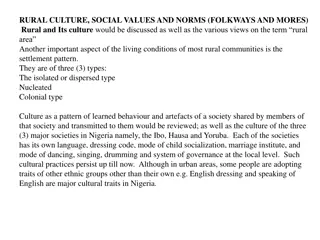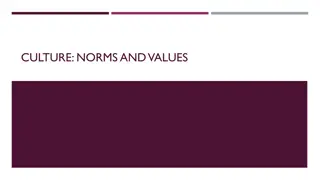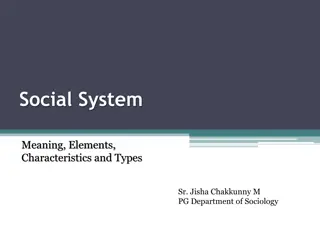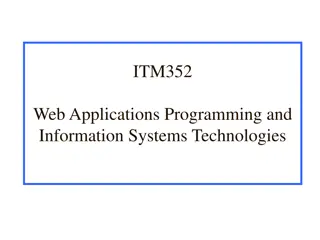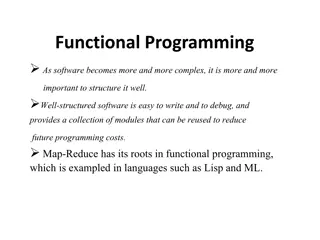Advancing Social Norms in SBC Programming
Explore the nuances of social norms programming and its impact on behavior change initiatives. Delve into the strategies and evolution of shifting social norms for effective outcomes.
Download Presentation

Please find below an Image/Link to download the presentation.
The content on the website is provided AS IS for your information and personal use only. It may not be sold, licensed, or shared on other websites without obtaining consent from the author. Download presentation by click this link. If you encounter any issues during the download, it is possible that the publisher has removed the file from their server.
E N D
Presentation Transcript
Shifting Social Norms as Part of Social and Behavior Change Presenter, Organization
SHIFTING SOCIAL NORMS AS PART OF SBC Overall Course Objectives Discuss and explore advances in social norms programming, the relation of norms-shifting interventions (NSI) to behavior change efforts, and their role in health and other sector programming. Share design, implementation, and evaluation challenges and solutions of community-based SBC projects engaging in, expanding, or planning to expand normative change efforts. Explore next steps to further collective learning about such promising interventions globally.
Shifting Social Norms as Part of SBC 1 2 3 4 5 INTRODUCTION ASSESSMENT DESIGN MEASUREMENT SCALE-UP Why Social Norms Matter Assessing Social Norms to Inform Program Design and Implementation Strategies Designing Norms- Shifting Interventions Measuring Normative Shifts in Complex Environments Scaling Up Norms-Shifting Interventions Effectively and Ethically
SHIFTING SOCIAL NORMS AS PART OF SBC CHANGE Welcome & Introductions
MODULE FIVE Scale-Up of Norms-Shifting Interventions Adaptation, Expansion, and Institutionalization Photo credit: IRH
1 2 3 4 5 Basic Scale-Up Concepts. Section Considerations for Planning Scale-Up Processes. Section Overview Assessing Social Norms Tips for Planning and Managing NSI Scale-Up. Section Assessing NSI Design for Scalability. Section Seven Guideposts for Design Adaptation, Monitoring, and Evaluation. Section
SCALE-UP OF NORMS-SHIFTING INTERVENTIONS Learning Objectives During this session, participants will: 1. Discuss key scale-up concepts and considerations that influence adaptation, expansion, and institutionalization of norms-shifting interventions. 2. Develop a perspective of the temporal nature (waves) of scale-up and related technical and management issues to address. 3. Define the seven Guideposts for designing and adapting NSI, monitoring implementation, diffusing new ideas and social shifts, and evaluating NSIs as they are scaled. 4. Begin to apply the concepts, temporal nature, and seven Guideposts in relation to their own projects.
POLL A Moving Survey What is your level of understanding of scaling up an intervention, on a scale of 1 to 5? Photo credit: Paula Bronstein/Getty Images/Images of Empowerment
SECTION 1 Basic Scale-Up Concepts
Deliberate efforts to increase the impact of innovations successfully tested in pilot or experimental projects so as to benefit more people and to foster policy and program development on a lasting basis. DEFINITION Scaling Up Source: World Health Organization (WHO) and ExpandNet, Nine Steps for Developing a Scaling-Up Strategy (Geneva, Switzerland: WHO, 2010).
Key scale-up concepts and principles Use a systems approach. Adding an innovation to a system affects all parts/sub systems; implemented within a specific context or setting. Focus on sustainability. Thinking of what remains after a project ends provides the longer-term focus on institutionalization and resource continuation. Be conscious of equity. Pay attention to the needs and rights of vulnerable groups, client-centered services. Rely on evidence and adaptive learning approaches to guide innovation development, scale-up strategies, and implementation approaches. Apply scale-up theory. Use diffusion of innovation theory and complexity theory to ground scale-up processes.
Scale-Up: Art and Science
A View of Scale-Up Over Time: A Multi-Organization, Multi-Year Process INTEGRATE expand for sustained health and social impact INTRODUCE demonstrate scalability in non- pilot contexts INNOVATE conceptualize and pilot ADVOCATE COLLABORATE COMMUNICATE RESULTS Where is your project? Adapted from the PATH scale-up diagram
What are Husbands Schools? Principal Objectives 1. To involve men in the promotion of reproductive health (RH). 2. To promote behavior change of men at the community level. Photo credit: Institute for Reproductive Health
What are Husbands Schools? Background Based on voluntary membership and community involvement to make men direct actors in development. Provides space for discussion, decision-making and action. Analyzes and discusses barriers to reproductive health to find responses adapted to local contexts. Strengthens and involves husbands as direct actors in the development of their community. All members are equal. Photo credit: Institute for Reproductive Health
Scale-Up Pathways Husbands Schools (2007-2017)
SECTION 2 Considerations for Planning Scale-Up Processes
Frameworks Common in Global Health to Guide Scale-Up Practice EXPANDNET/WORLD HEALTH ORGANIZATION BROOKINGS INSTITUTION MANAGEMENT SYSTEMS INTERNATIONAL SCALING SOCIAL IMPACT MODELS COMMONALITIES: Systems focus, sustainability of effect, managing change
Environment The NSI User Scaling-up Strategy Framework for Strategic Scale-Up, Adapted From Expand Net Organization(s) Resource Team Type of scale up Horizontal, Vertical, and/or Adaptation Strategic Choices Cost/Resource Mobilization Dissemination & Advocacy Organizational Processes M&E Source: WHO and ExpandNet, Nine Steps for Developing a Scaling-Up Strategy (Geneva, Switzerland: WHO, 2010).
A project or initiative that is new or perceived as new in a specific context. A practice (e.g., a product or approach, such as a community-centered campaign or social media initiative, that is norms-shifting in nature) and the logistical processes necessary for successful implementation. A package that is transferrable with contextual modification. WHAT WE MEAN BY An Innovation
NSI-Innovation Considerations Be explicit in defining the innovation, including the package and its implementation supports. Which parts of the package are norms- shifting? What are the norms-shifting pathways and expected outcomes (theory of change)? Engage different-level stakeholders in defining the innovation. Environment The NSI-Innovation User Scaling-up Strategy Organization(s) Resource Team Source: WHO and ExpandNet, Nine Steps for Developing a Scaling-Up Strategy (Geneva, Switzerland: WHO, 2010), page 9.
Credible Observable Relevant Relative advantage Easy to install Compatible Testable Is your innovation CORRECT?
DECISION TIME You might really like the NSI-innovation, but before you jump to scale-up, it s important to consider EFFECTIVENESS READINESS How effective is the NSI? Does it lead to norms-shifting & contribute to behavior change? What is the evidence of norms- shifting processes? Does the community accept the NSI? Is the resource team ready? How much will you need to build capacities of the user organizations? Do user organizations have flexibility to integrate NSI in their existing projects?
ACTIVITY In your own experience 1. Thinking about scale-up waves (innovation, introduction, wide-scale integration), how far have you ventured into scale-up? 2. Have you ever had to stop and adjust an innovation as you moved to a new region? Were the challenges related to being CORRECT? Or other factors? Photo credit: Jonathan Torgovnik/Getty Images/Images of Empowerment
Planning a Scale-Up Process Identify key players and allies in shifting norms in new settings. Be clear on end goals and strategies to move scale-up processes. Determine the extent to which NSI activities need to be adapted without losing effectiveness. Think ethically during scale-up planning and implementation. Expect similar challenges to those experienced during piloting as you move into scale Photo credit: https://www.gettyimages.com/detail/photo/mature-counselor-listens- compassionately-to-royalty-free-image/1207514066?adppopup=true
Key Players: User Organization and Resource Team RESOURCE TEAM USER ORGANIZATION May include multiple organizations. Seeks to adopt and implement the innovation. Individuals/organizations involved in development and testing. Often becomes part of the resource team. Seek to promote its wider use. Environment The NSI-Innovation User Scaling-up Strategy Organization(s) Resource Team Source: WHO and ExpandNet, Nine Steps for Developing a Scaling-Up Strategy (Geneva, Switzerland: WHO, 2010).
Environment Health & other sectors Bureaucracy Socioeconomic & cultural context Policy/politics People s needs & rights The NSI-Innovation Scaling up Strategy User Organization(s) Resource Team ENVIRONMENT Conditions and institutions that are external to the user organizations, but fundamentally affect the scale-up process. Environment is ever-changing and needs to be regularly monitored.
Three Main Types of Scale-Up Strategies Expansion Adaptation Institutionalization (Diversified Scale-Up) (Vertical Scale-Up) (Horizontal Scale-Up) Political Policy Institutional Legal Expansion Adapting the NSI- innovation to fit into new organizations and new social contexts Replication
Scale-Up Needs Strategic Balance INSTITUTIONALIZATION SCALE- UP (POLITICAL, POLICY, INSTITUTIONAL, LEGAL) EXPANSION/REPLICATION
Sustainability Be clear on the goals for NSI Sustainability of NSI activities? OR Sustainability of normative shifts? (Is the NSI still needed?) INSTITUTIONALIZATION (POLITICAL, POLICY, INSTITUTIONAL, LEGAL) SCALE- UP EXPANSION/REPLICATION
SECTION 3 Tips for Designing NSIs for Scale-Up
Designing the NSI Innovation Our KISS challenge: Keep It Simple and Scalable begin with the end in mind. Photo credit: BRO Vector
Lean Innovations SIMPLE ACCEPTABLE LOW-RESOURCE Simple materials. Easy-to-use. Uses existing platforms. Catalyze reflective dialogue. Fun, engaging activities to ensure use. Rooted in deep understanding of context. Low-cost materials. Feasible to integrate into multi-sector programs. Minimal need for support and supervision after base training.
Lean Materials Photo credit: Institute for Reproductive Health
Lean Strategies Work with existing platforms, groups, and influential community members. Strategic targeting of change actors. Minimal orientation and coaching. Use media to increase diffusion. Monitor community acceptability and intervention stickiness. Photo credit: Institute for Reproductive Health
SECTION 4 Assessing NSI Design for Scalability
Part 1: Defining the NSI-Innovation MAIN COMPONENTS OF THE INNOVATION PACKAGE SUPPORT ACTIVITIES TO OFFER THE COMPONENT Key activities/strategies, e.g., community-level outreach, mass media campaign, services linkage Needed support actions, e.g., training, materials Example: High quality training-of-trainers, and high-quality training of mentors to make sure norms-shifting approaches come through clearly during mentoring Example: A mentorship model where community elders work with young men to shift the norms that perpetuate violent discipline of children
Part I1: Assessing NSI Scalability COMMENTS/ CONCERNS HOW SCALABLE IS THE INTERVENTION? YES/NO/MAYBE Relevance and relative advantage Responds to perceived problems? Accounts for community, cultural, gender, other social factors? Tested and shown to be effective? Ease of use by other organizations/programs Simple to use? Easy to integrate into existing programs? Reasonable cost to implement (human, material, financial)? Compatibility with new user organization Aligns with development objectives of receiving organization? Aligned with its organizational values? Sufficient capacity to absorb new activities?
Assessing Scalability: Relevance, Ease, and Compatibility Relevance and relative advantage Responds to perceived problems. Accounts for community, cultural, gender, other social factors. Sufficiently effective to help decrease identified problems. Easy to install Simple to use. Easy to integrate into existing program. Reasonable cost to implement (human, material, financial). Compatible with receiving organization Aligns with development objectives of receiving organization. Aligns with values. Sufficient capacity to absorb new activities.
SECTION 5 Seven Guideposts for Design Adaptation, Monitoring, and Evaluation
Seven Guideposts for NSI Scale-Up NSI DESIGN ADAPTATION DURING SCALE-UP 1. Understand the NSI s theory of change, its underlying values and change mechanisms, for effective transfer to new organizations. 2. Remember that adaptation is an option, but you need to KISS! 3. Many NSIs operate outside of health systems and need linkages. MONITORING IN NEW CONTEXTS 4. Ensure new staff have technical and social change competencies. 5. Monitor whether NSI activities are leading to social change and idea diffusion at the community level. 6. Monitor the receiving social system for unexpected opposition and other unanticipated effects. EVALUATION 7. Be multi-dimensional in outcome measurement and move beyond the individual. Photo credit: Aknarin Thika / EyeEm
GUIDEPOSTS FOR NSI DESIGN AND SCALE-UP Understand the NSI s TOC, its underlying values and change mechanism for effective transfer to new organizations. New users need to understand how the NSI works not only its essential elements but the concepts and values underpinning it. Resource team members should ensure new implementers understand the foundations of the NSI its TOC and norms-change mechanisms. Just because you know where you are going does not mean you know how you get there!
GUIDEPOSTS FOR NSI DESIGN AND SCALE-UP Remember that adaptation is an option, but you need to KISS! Maintain the KISS challenge in intervention adaptations. Assess adaptation options using a scalability lens. Reflect scalability realities in your decisions. Our KISS challenge: Keep It Simple and Scalable
GUIDEPOSTS FOR NSI DESIGN AND SCALE-UP Many NSIs operate outside of health or other service systems and need linkages. In new contexts, build in or negotiate services linkages for more effective behavior change strategies and sustained effect.
GUIDEPOSTS FOR NSI DESIGN AND SCALE-UP Ensure new staff have technical AND social change competencies. Invest up-front in frontline workers and other staff through values, gender, and other norms clarification and their roles as change agents. Frontline workers are critical to the norms-shifting task; consider norms clarification exercises throughout implementation to deepen understandings. Regular learning, exploration, reflection, and challenging of assumptions is key to developing social change competencies.
GUIDEPOSTS FOR NSI DESIGN AND SCALE-UP Monitor whether NSI activities are leading to social change and idea diffusion at the community level. Fidelity monitoring of NSI extends beyond activity monitoring. Is the NSI producing observable social change, e.g., more public discussion on sensitive issues? Is the NSI effectively diffusing new ideas and model behaviors to those not directly reached by the NSI?
GUIDEPOSTS FOR NSI DESIGN AND SCALE-UP Monitor the receiving social system for unexpected opposition or other changes. Both frontline workers and general community can be affected. Determine NSI project response. Know your organizational position vis- -vis mitigating social push back when power structures are threatened. Be ready to support early positive changes positive-deviant behaviors, public proclamations as they emerge.
GUIDEPOSTS FOR NSI DESIGN AND SCALE-UP Measure multiple dimensions of outcomes and move beyond the individual. Define expected normative change; not just individual behavior change. Intervention end points normative change tipping points. Institutionalization- High Impact Practices 90 90 80 70 60 Individual behavior change Institutionalization - Budget line 50 70 40 30 40 20 10 0 25 Community opposition to new behavior User org capacity to offer NSI with minimal support 80 55 Community agreement with new behavior
SCALE-UP OF NORMS-SHIFTING INTERVENTIONS Concluding Reflections and Key Takeaways
At each moment of new-wave expansion, pause to ask whether to continue scale-up. Does the NSI effectively shift norms in the new context? Are new user organizations able to offer the NSI as planned? What is the community capacity in new areas to manage the effects of the NSI? Photo credit: Mayur Kakade



